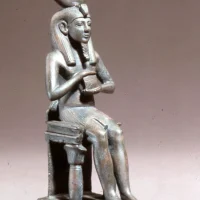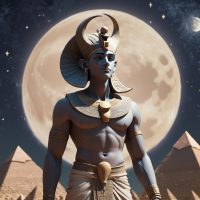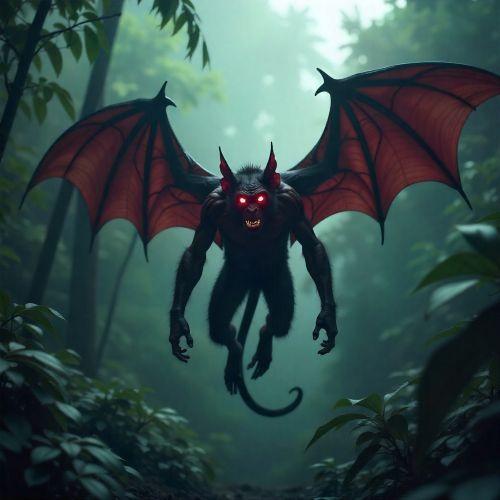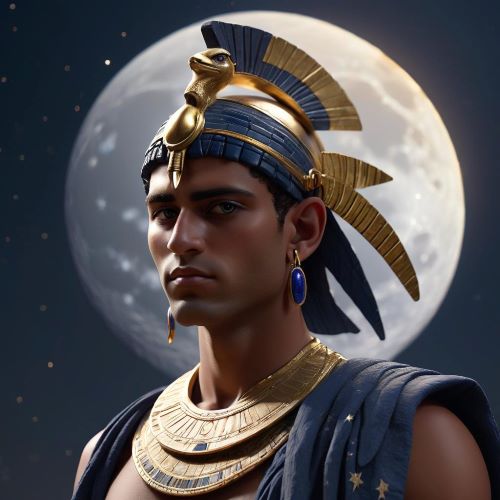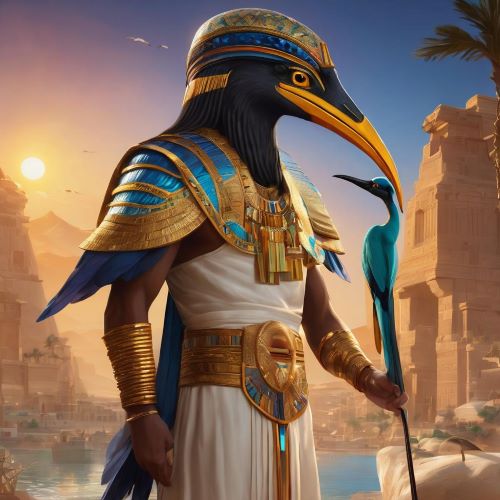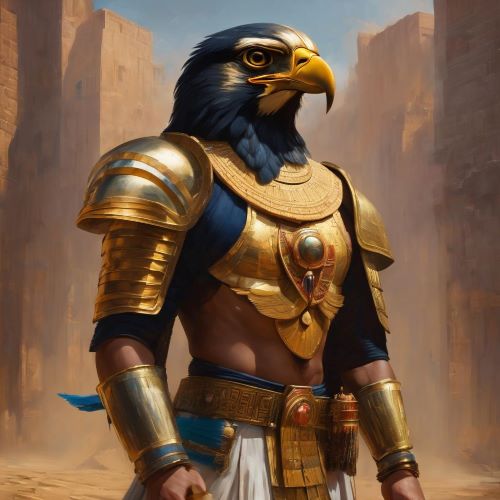Iah : The Moon God
Listen
At a glance
| Description | |
|---|---|
| Origin | Egyptian Mythology |
| Classification | Gods |
| Family Members | N/A |
| Region | Egypt |
| Associated With | Moon |
Iah
Introduction
Iah, also known as Yah, Jah, Aa, or Aah, is one of the earliest lunar deities in ancient Egyptian mythology. His name directly translates to “Moon,” reflecting his celestial dominion. Emerging during the Old Kingdom around 2613 BCE, Iah represented the personification of the moon long before the rise of Khonsu, who would later assume many of his attributes. In Egyptian belief, the moon was not only a light in the darkness but also a divine regulator of time, fertility, and rebirth. Iah thus became a symbol of cyclical renewal and cosmic order. His worship, though never as dominant as that of Ra or Osiris, marked a significant phase in Egypt’s evolving understanding of the heavens and their connection to divine power.
Physical Traits
Depictions of Iah often show him as a youthful and serene man with pale, almost silvery skin, signifying the glow of moonlight. He typically wears a lunar disk and crescent moon on his head, a visual marker of his celestial role. In some temple reliefs, he is shown standing or seated beside Thoth or Khonsu, gods who share his lunar aspects. Occasionally, Iah’s image appears more stylized — wearing a full wig or the Atef crown adorned with lunar emblems, further linking him with kingship and divine balance. Unlike solar deities, who were associated with radiant strength and dominance, Iah’s imagery projects calm illumination and rhythmic harmony. The crescent moon symbol itself was sometimes likened to the horns of a bull, connecting Iah to fertility, strength, and the regenerative cycles of nature that the Egyptians observed in both the heavens and the Nile’s tides.
Family
Though Iah’s direct lineage is not clearly recorded, Egyptian mythology often connected him to other lunar and creative deities. In later periods, he was identified as an older or more primordial version of Khonsu, the youthful moon god worshiped in Thebes. Because Khonsu was considered the son of Amun and Mut, Iah sometimes became indirectly associated with this Theban triad. Moreover, through his connection to the moon’s renewal, Iah was symbolically linked to Osiris, the god of resurrection and the afterlife. This association reinforced the idea of rebirth that the moon represented—disappearing and reappearing in the sky, just as Osiris was said to die and rise again. The royal family of the 18th Dynasty showed particular devotion to Iah; names such as Ahmose (“Born of Iah”) and Yahhotep (“Iah is content”) reflect how deeply his worship influenced Egyptian culture and even royal identity.
Other names
Over time, Iah’s name appeared in several forms depending on regional dialects and transliteration conventions. Variants such as Yah, Jah, Aa, and Aahu all stem from the same root meaning “moon.” In later Egyptian and Coptic writings, the name was preserved as ⲟⲟϩ (Ooh), ensuring that his linguistic legacy continued into the Christian era of Egypt. Some scholars have noted phonetic similarities between “Iah” and Semitic divine names like “Yahweh” or “Allah,” but linguistic and archaeological evidence show these are unrelated traditions. The Egyptian Iah was purely lunar, representing time and rebirth, not a supreme creator god. His later title, “Iah-Djehuty,” or “the Moon as Thoth,” signified his absorption of Thoth’s intellectual and time-keeping aspects, blending the lunar symbolism of both deities. This syncretism illustrates how Egyptian religion evolved by merging similar divine functions into unified representations of cosmic balance.
Powers and Abilities
As a lunar deity, Iah’s powers were deeply tied to the natural rhythms of the cosmos. He governed the measurement of time, as the lunar cycle formed the foundation of the Egyptian calendar. Farmers relied on his phases to plan sowing and harvesting seasons, while priests used them to determine the timing of festivals and sacred rituals. His light provided guidance during the night and symbolized order within chaos.
Iah’s role in myth extended to the creation of the 365-day calendar. According to Egyptian legend, when the sun god Ra cursed the sky goddess Nut, forbidding her from giving birth on any day of the year, Thoth—another moon-associated deity—challenged Iah to a game of Senet, a popular Egyptian board game. By winning, Thoth gained enough moonlight to create five extra days beyond the 360-day year. These became the birthdays of the gods Osiris, Isis, Horus, Set, and Nephthys. The myth explained both the moon’s cyclical waning and the origin of Egypt’s solar-lunar calendar, emphasizing Iah’s vital role in maintaining the balance between cosmic forces.
In later texts like The Teachings of Amenemope, Iah also appears as a divine enforcer of moral justice. Those who broke oaths or committed deceitful acts were said to be bound by his divine light, a poetic metaphor for conscience illuminated by the moon. His recurring presence in both moral and cosmological contexts highlights how Egyptians viewed the moon as a universal regulator—not just of time, but of ethical and spiritual order.
Modern Day Influence
While Iah’s cult eventually declined as Khonsu became the dominant moon god during the New Kingdom, his legacy remains visible in art, literature, and modern interpretations of Egyptian mythology. Archaeologists and Egyptologists continue to study him as a key transitional figure who bridges early natural worship with later theological sophistication. His imagery—of a youthful figure crowned with the moon—appears in museum collections worldwide, including the British Museum and the Egyptian Museum in Cairo, often misattributed to Khonsu due to their visual similarity.
In the modern era, Iah’s symbolism endures through continued fascination with lunar cycles, rebirth, and balance. Contemporary writers and creators often reference him in works exploring the mysteries of the night sky, aligning him with the timeless human connection to the moon. Online platforms and mythology databases feature Iah as part of a wider exploration of lunar deities from around the world, emphasizing his role as an early conceptualization of time’s cyclical nature.
His influence also persists indirectly in cultural and religious systems that use lunar calendars, including Islamic, Jewish, and certain Christian traditions. Although these calendars have separate theological origins, they reflect the same ancient human awareness of the moon’s role in structuring time—an awareness that Iah once personified in divine form.
Ultimately, Iah represents more than a forgotten lunar god; he embodies humanity’s enduring effort to understand and synchronize with the rhythms of the universe. Through his calm light and cyclical rebirth, Iah continues to symbolize renewal, order, and the infinite dance between darkness and illumination. Even after thousands of years, his story reminds us that time itself—measured by the changing moon—is one of humankind’s oldest and most sacred relationships with the cosmos.
Related Images
Source
British Museum. (n.d.). Ancient Egyptian gods and goddesses. Retrieved from https://www.britishmuseum.org
Hart, G. (2005). A Dictionary of Egyptian Gods and Goddesses. London: Routledge Press.
Iah. (2002). In Wikipedia: The Free Encyclopedia. Retrieved from https://en.wikipedia.org/wiki/Iah
Simple English Wikipedia. (2019). Iah (Egyptian Moon God). Retrieved from https://simple.wikipedia.org/wiki/Iah
Tour Egypt. (n.d.). Yah (Lah), the Other Egyptian Moon God. Retrieved from https://www.touregypt.net/featurestories/yah.htm
Visit Egypt. (2025). Egyptian Gods Names and Powers: Ancient Myths Explained. Retrieved from https://visitegypt.com/egyptian-gods-names-and-powers/
r/Religion. (2023). Lah – The Moon God? Or is it? Retrieved from https://www.reddit.com/r/religion/comments/11h8zyi/lah_the_moon_god_or_is_it
Britannica. (2025). 11 Egyptian Gods and Goddesses. Retrieved from https://www.britannica.com/list/11-egyptian-gods-and-goddesses
Frequently Asked Questions
What is lorem Ipsum?
I am text block. Click edit button to change this text. Lorem ipsum dolor sit amet, consectetur adipiscing elit. Ut elit tellus, luctus nec ullamcorper mattis, pulvinar dapibus leo.
What is lorem Ipsum?
I am text block. Click edit button to change this text. Lorem ipsum dolor sit amet, consectetur adipiscing elit. Ut elit tellus, luctus nec ullamcorper mattis, pulvinar dapibus leo.
What is lorem Ipsum?
I am text block. Click edit button to change this text. Lorem ipsum dolor sit amet, consectetur adipiscing elit. Ut elit tellus, luctus nec ullamcorper mattis, pulvinar dapibus leo.
What is lorem Ipsum?
I am text block. Click edit button to change this text. Lorem ipsum dolor sit amet, consectetur adipiscing elit. Ut elit tellus, luctus nec ullamcorper mattis, pulvinar dapibus leo.
What is lorem Ipsum?
I am text block. Click edit button to change this text. Lorem ipsum dolor sit amet, consectetur adipiscing elit. Ut elit tellus, luctus nec ullamcorper mattis, pulvinar dapibus leo.


